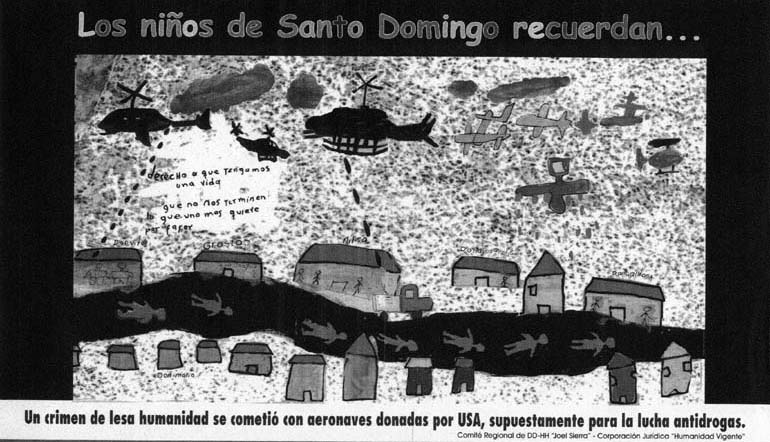 |
Waging War Against ChildrenBy Barry RomoColombia is set to receive 1.3 billion dollars in military aid. This makes it third in American aid largess, right behind Israel and Egypt. We have decided to take our stand with a corrupt government, corrupt military and death squad militias. Of course, it is not Vietnam. They speak Spanish, not Vietnamese. Even so, the constant input of funds, military equipment, advisors and special operations personnel makes Colombia look like Saigon in 1960. According to international human rights organizations, there were 399 massacres last year. The guerrillas and their allies are responsible for only twelve of these massacres. Our aid money goes to pay for the other 377 massacres, by the Colombian authorities, against their own people. Early this year, I was asked to go on a fact-finding mission to a small Colombian village in Arauca, called Santodomingo. There was confusion about the nature of a massacre which occurred on December 19, 1998. The villagers claimed that government helicopters bombed the village. This attack resulted in the deaths of nineteen people - seven of them were children - and the serious injury of twenty-five others. The government, backed by the United States, discounted the victims' report and claimed that they were all injured by a single, homemade claymore mine, made by the guerrillas. I went to Colombia in June to investigate this atrocity and to interview the victims. My trip was facilitated by Catholic human rights activists. People warned me about the danger, of which of course I was already aware. I also realized that these activists faced death and torture every day from US-backed thugs. I flew to Arauca, which is on the border of Venezuela. Arauca has a lot of oil pipelines and facilities. To get to Santodomingo we had to travel in extremely old and tired SUVs over roads that would make a farm tractor road look paved. The village is typical of many third world agricultural areas. Tin roofs, open doors and dirt floors are normal there. The people are shaped by trying to survive off the land and raise their children to have an education and a better life. In fact, when the attacks occurred, the villagers in Santodomingo were having a fiesta to raise funds for a school. In the middle of the festivities, on December 13, 1998, the Colombian military, in US-provided Huey helicopters loaded with American bombs and rockets, slaughtered villagers. Children and grandchildren were killed in front of their parents. A mother was decapitated. When people tried to drive the survivors to a hospital, they were followed by the Hueys for three kilometers, under fire. Not only did the voices of the victims tell a story, the physical evidence proved that it was the government that was responsible for the attack, not the guerrillas. There was not one explosion, but four. The shrapnel was not the nuts and bolts of a homemade mine; it was aluminum from an AN-M41 fragmentation bomb. Armed with this information, VVAW participated in a tribunal, together with the Center for International Human Rights located at Northwestern University Law School. The tribunal was organized by Professor Doug Cassel, who has dedicated his life to human rights issues. Besides VVAW's participation, we had an unexpected ally: the FBI. While I was examining Santodomingo, they were issuing a secret report that they found fragments and a fuse, as well as other bomb parts, directly pointing to the Colombian military. One of the sad things about Colombia today is that this massacre was only one of about 400 that occur every year. The level of violence is not diminishing. It is increasing. Priests, nuns, brothers, and lawyers are in the front lines of the struggle to defend the Colombian people from authorities who can act with total impunity with regard to murder and torture. It's not about the drugs. It is much more about the oil, the political location of the country, and the guerrillas. Everybody has a hand in the drug profits. The death squads, the guerrillas, the military, and the government all get a slice of this lucrative pie. This situation calls for increased activity by those of us involved in the struggle for peace and justice. People said that I was brave for going to Colombia, but I was only a tourist sharing their pain and danger for a week. The poor people of Santodomingo and countless other villages across Colombia must live this nightmare every day. Our aid, both military and financial, does not contribute to a solution. It makes a settlement impossible.

|

